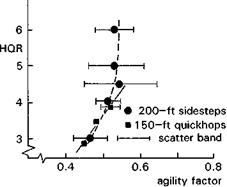Agility factor
The DRA tests described above were part of a larger research programme aimed at providing a better understanding of the flying qualities deficiencies of current military types and quantifying future requirements. Of special interest was the impact of flying qualities on agility; the concept of agility will be developed further in Chapter 7 but, for this introductory Tour, a suitable definition is (Ref. 2.38)
the ability to adapt and respond rapidly and precisely with safety and with poise, to
maximize mission effectiveness.
A key question that the results of the above research raised concerned how the agility might be related to the flying qualities. One interpretation the author favours is that agility is indeed a flying quality. This is supported by the concept of the agility factor: if the performance used in a particular MTE could be normalized by the performance inherently available in the aircraft, then in the limit, this ratio would reveal the extent of usable performance. A more convenient way of computing this factor is to take the ratio of the theoretically ideal task time with the achieved task time. The ideal time is computed based on the assumption that the time to maximum acceleration is zero. So in the sidestep, or any similar lateral translational manoeuvre for example, the bank angle changes are achieved instantaneously. In a pure bank and stop manoeuvre, the roll rate would be assumed to develop instantaneously. The agility factor is useful for comparing the inherent agility of configurations with the same performance or competing to meet the same performance requirements. The calculation procedure and some of the factor’s nuances will be elaborated on in Chapter 7. The Puma sidestep and quickhop MTE data converted to agility factors are shown with the HQRs in Fig 2.44. The trends shown previously in the time plots now appear even more dramatic; maximum agility factors for the Puma of 0.5-0.6 are achievable with borderline Level 2/3 HQRs only. The pilot can barely attain the adequate performance level, even with considerable workload. These tests were conducted in a clinical environment, with well-defined ground features and flown by skilled test pilots with opportunity to
|
Fig. 2.44 HQRs versus agility factor for the Puma flying sidestep and quickhop MTEs |
practice. In a real-world situation, the increased workload from other duties and the uncertainties of rapidly changing circumstances would inevitably lead to a further loss of agility or the increased risks of operation in the Level 3 regime; the pilot must choose in favour of safety or performance.
In agility factor experiments, the definition of the level of manoeuvre attack needs to be related to the key manoeuvre parameter, e. g., aircraft speed, attitude, turn rate or target motion. By increasing attack in an experiment, we are trying to reduce the time constant of the task, or reduce the task bandwidth. It is sufficient to define three levels – low, moderate and high, the lower corresponding to normal manoeuvring, and the upper to emergency manoeuvres.












